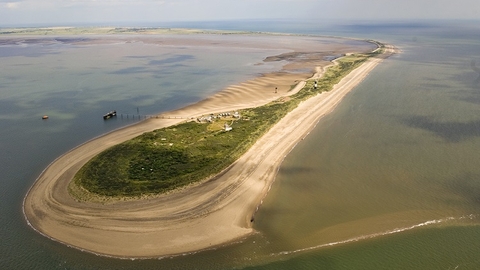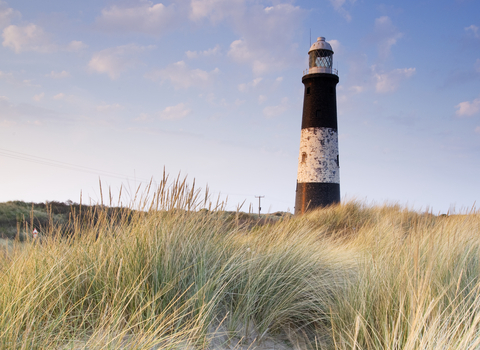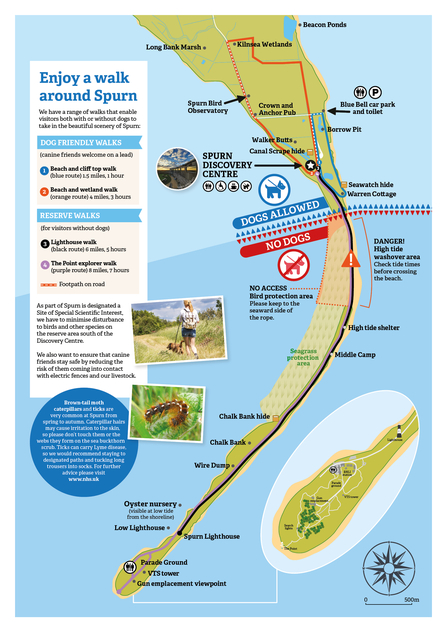Spurn Discovery Centre and café will be open 7 days a week from Thursday 3rd April (with the first full week being the week of 7th April). The Centre will remain closed on Tuesday 1st and Wednesday 2nd April.
The Spurn Explorer bus service will resume on Sat 5th April until Sun 2nd Nov; the bus service will operate on Saturdays and Sundays only.

Spurn National Nature Reserve (c) David Nichols
Spurn National Nature Reserve
Location
Know before you go
Dogs
When to visit
Opening times
The reserve is open at all times (unless bad weather poses a risk to visitors). Please see Spurn Discovery Centre for opening times of the centre.Best time to visit
March to NovemberAbout the reserve
Spurn Point is Yorkshire's very own Lands End - an iconic and constantly moving peninsula which curves between the North Sea and the Humber Estuary. At over three miles long but as little as 50 metres wide, this landscape is unique and ever-changing.
Spurn has an extensive human history, leaving a legacy of fascinating but derelict buildings and hidden structures. But Spurn remains, and will always be, an utterly wild place. Always at the mercy of the elements, no two days at Spurn are ever the same.
Plan your visit
Nestled in among the ever-changing landscape, Spurn Discovery Centre is the perfect base to begin your adventure. With toilets, cafe, education hub, events and more, visit the Discovery Centre page to plan your visit.
Tide times
Jutting out into the mouth of the Humber, Spurn is very much exposed to the elements. Visitors should be aware that there is a 1km 'washover' section of sand which is sometimes covered by water at high tide, effectively cutting the end of the peninsula off from the mainland, creating Yorkshire's first 'island'!
Strong currents and soft sand underfoot mean that it can be very dangerous to cross the washover section at high tide (marked 'Danger' on the map below). Dates and times where tide heights are known to create dangerous conditions are listed under the ‘do not cross’ times below.
Visitors should be aware that weather conditions can also have an impact on tide height, and we strongly advise checking the weather forecast and tide times ahead of your visit as well as any flood alerts that may be in place.
If water is present on the washover area during high tide, no attempt should be made to cross until the water has receded.
Please note
In the scrub around the base of the lighthouse, and along into Chalk Bank, you may notice what look like tents stretched between branches, which are in fact the overwintering silk tents of the brown tail moth caterpillar. Whilst for many these caterpillars are harmless, they can cause itchy allergic skin reactions or respiratory issues for those with asthma or hay fever – so please don’t touch the caterpillars or the tents.
Environmental designation

Puffin - (C) Jim Highman
Help create a Yorkshire rich in wildlife
Yorkshire is home to magical wildlife and wild places. It’s undeniably special, but it’s also under serious threat.
Nature can't act to stop and reverse these trends - but together we can!
Will you join Yorkshire Wildlife Trust and make a real and lasting difference?
About
Spurn is an iconic National Nature Reserve, famous for bird migration, but also for a wide range of other important wildlife and cultural heritage. Birds are the most visible migrants, but impressive movements of insects, including hoverflies, ladybirds, dragonflies and butterflies can occur.
A long, narrow, crooked finger of sand reaching out from the Holderness coast across the mouth of the mighty River Humber. This is Spurn, one of Yorkshire Wildlife Trust’s most iconic nature reserves. It is a wildlife-rich mosaic of beach, mudflats, saltmarsh, dunes, grassland, open water, saline lagoons and native sea buckthorn scrub.
Due to its prominent position, huge numbers of birds pass through Spurn during the year. The numbers and types of birds varies from week to week and is influenced by the weather conditions. The adjacent Humber Estuary is of international importance for its vast numbers of wildfowl and wading birds, which can be seen on passage in spring and autumn and during the winter.
Spurn is similarly rich in other wildlife but this may not be obvious at first glance. Plants are the first feature noticed, with the marram grass-topped dunes interspersed with stunted elder and orange-berried seabuckthorn bushes. On the Humber side of Spurn, a strip of saltmarsh exists between the land and the mudflats, supporting colourful flowering plants including sea lavender, sea aster and sea rocket, along with common glasswort and eel grass. Curlew, grey plover and knot use the saltmarsh to roost at high tide. Look out for merlin and peregrine which cause panic among the flocks of roosting wading birds when they start to hunt. Shelduck and brent geese are conspicuous on the mudflats during the winter.
In spring and summer a range of wildflowers appear in the grassland areas which the Trust manages by grazing with sheep and cattle, and also by cutting.
Magenta pyramidal orchids grow here and closer inspection of short grass may reveal the rare suffocated clover. Sea holly grows amongst the dunes.
Roe deer are a regular sight in these grassy areas, particularly early in the morning, which is also a good time to see a fox. A look over the sea will not only reveal passing seabirds including locally breeding little tern in the summer but also a chance of a harbour porpoise or even a minke whale.
Seasonal highlights
- Spring: Birds - Whimbrel; Wheatear; Ring ouzel; Plants - Scurvy grass
- Summer: Invertebrates - Red-veined darter; Birds - Little tern; Mammals - Harbour Porpouise; Plants - Suffocated clover
- Autumn: Birds - Woodcock; Wryneck; Whinchat; Yellow-browed warbler; Great grey shrike
- Winter: Birds - Brent goose; Shelduck; Merlin; Snow bunting; Mammals - Harbour seal
Directions by car or public transport
Public transport
Catch the number 71 Spurn Explorer bus from Hull Interchange to Easington/Withernsea on weekends and bank holidays and get off directly outside the Spurn Discovery Centre.
By car
Follow the A1033 from Hull to Patrington. Turn off (right) to the B1445 towards Easington and Kilnsea. Turn right at the T junction in Easington and continue along the minor road to Kilnsea. Turn right at the crossroads towards the Spurn Discovery Centre. Car park is on your left.
Drones, kites and other filming
Please remember that this is a nature reserve and that it is managed first and foremost for the wildlife that lives here. As part of the Humber SSSI/SPA/SAC, Spurn Point is legally protected for its breeding, migrating, and wintering bird populations. For this reason, we do not permit activities – for example, kite flying – that might disturb the species that make this place so special.
If you are interested in taking commercial photographs or filming at Spurn, please contact us via the webform available on our filming enquiry page.
Please note that it is not permitted to use drones at Spurn without a license from Natural England. Further information is available here.
Reserve map
Click the map below to zoom in.

(C) VisitBritain Lee Beel
Our award winning lighthouse
We’re delighted that Spurn lighthouse has been awarded the Lighthouse of the Year award 2023 by the Association of Lighthouse Keepers.
This lasting example of Victorian architecture was built in 1895 - guiding sailors around our coastline for over 90 years, until it was decommissioned in 1985.
We couldn’t maintain this historic Yorkshire landmark without the help of our dedicated and passionate volunteers – thank you for helping us keep the candle burning.
Our lighthouse is open every weekend, so why not join us for a tour and discover this culturally important building for yourself.

Walking your dog at Spurn
We're happy to welcome dogs to certain areas of Spurn, but we restrict access to other areas. We've explained why some areas are off-limits, and given you some ideas for dog-friendly walks which still allow you to enjoy the Spurn experience!
Why are some areas of Spurn restricted to dogs?
We know most dog owners are conscientious, and will keep their dogs on leads and pick up their dog poo. However, even the most well-behaved dogs can cause upsets in the natural environment. Here's why:
- Dogs are a disturbance to birds. Spurn is home to a fabulous array of protected birds and other species. These animals are increasingly threatened, so protecting areas of land like Spurn, where they can thrive, is really important.
- Spurn National Nature Reserve is a designated Site of Special Scientific Interest. This means that, by law, we have to ensure the delicate ecosystems of the reserve are kept in balance. Dogs can upset this balance by rooting around undergrowth and disturbing animals. Dog poo can change the quality of the soil, which can encourage the wrong sorts of plants to grow.
- We have livestock grazing our land. Not only can dogs disturb or even threaten livestock, there are several nasty diseases which can be transmitted to sheep and cattle via dog poo. At the same time, seal poo can infect dogs with similar nasty illnesses.
Where can I walk my dog?
We're more than happy to welcome canine friends into our Spurn Discovery Centre, so please drop by for a visit! Look out for signs on the reserve which show you where you're able to walk your dog.
If you're after a good beach walk, you can head north from the Discovery Centre along the beach. Enjoy the sea air, big views and spot wildlife on the cliffs and in the water. Just turn around and head back for a cuppa when you're ready!
If you want a circular walk, you can do the Kilnsea Wetlands trail. Head north towards the Blue Bell and continue along Beacon Lane. Then follow the cut paths to the historic sound mirror and Kilnsea Wetlands. See waders, wildfowl and views over Kilnsea. Walk for a short distance along the grass verge until you reach Kilnsea village, and continue back along the path to the Discovery Centre. You'll need to keep your dog on a lead for this walk.
Where's off-limits for my dog?
Dog walkers can proceed past the gate at the end of Spurn Road, but must turn north at the start of the beach as shown by route 1 (blue route) on the map above. Dogs cannot be taken south along the beach, as routes 3 and 4 (black and purple routes) on the map are within the Site of Special Scientific Interest and are as such are restricted to visitors without canine friends.
Nearby
Make a full day of your adventure and take the opportunity to explore and enjoy other wild places close by.

